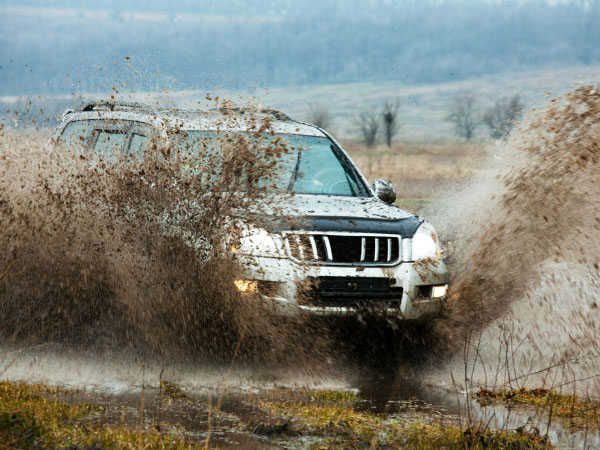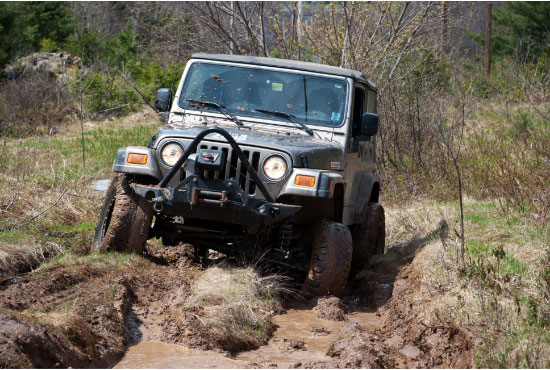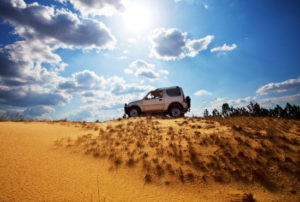I am often asked how fast a Jeep can go while it is in 4-wheel drive high.
The Jeep in 4-wheel drive high can ultimately go as fast as the speedometer will allow. With that said we must also point out that the manufacturer recommends speeds no greater than about 55 miles per hour for most vehicles being driven in 4-wheel drive high.
The manufacturer is obligated to suggest the safest driving speeds and observances. That does not mean the Jeep cannot be driven faster than the recommended speed, it means that the safest possible speed is nothing above that amount.
Four-Wheel Drive Facts

Four-wheel drive is designed to allow you to travel on surfaces that have poor traction and might be dangerous to drive over.
Wet surfaces, muddy surfaces, rocky surfaces, and similar surfaces often stop a regular 2-wheel drive vehicle from proceeding.
When you are about to encounter these hazardous road conditions then you switch your vehicle into four-wheel drive so all of the wheels are given equal power. With that equal power, each wheel can pull so if one or more wheels start to lose traction or spin the vehicle will still be traveling.
Four-Wheel Drive High

In this setting, the vehicle is likely to be driven faster than if it were traveling in 4-wheel drive low. The high setting is meant to be chosen when the road is smoother and flatter like a highway road is. It is intended to be used in situations when you are traveling on a smoother road but might encounter a loss of traction from water or light snow.
You can travel at faster rates of speed while in 4-wheel drive high, but you can also damage the transfer case of the vehicle if you try to drive too fast.
Four-wheel drive high is meant to help you travel across roads that have become slippery and may cause a loss of traction. That means that when you choose to use this setting the driving conditions are less than perfect so you need to slow down anyway.
Protect your vehicle, your engine, and your life by not driving in four-wheel-drive high at a rate of speed faster than 50 miles per hour.
When to use
- When you are crossing light sand
- When roads are wet and slippery
- When there is light snow on the roads
When to NOT use 4WD High
- On everyday dry surfaces
- On deep sand
- On ice
- At speeds above 55 miles per hour
- On steep inclines
- When driving through creeks or through deep waters
- When the driving terrain is so treacherous that you reduce your speed to 20 or below
Four-Wheel Drive Low

The low setting has a serious speed recommendation of fewer than 30 miles per hour. The optimal speed when you are driving in a four-wheel-drive low is 20 miles per hour or less. This is not just a recommendation it should be considered a law of four-wheel drive.
You do not engage the four-wheel-drive low unless the terrain is really going to impede traction. That means when you are driving through snow, mud, water, deep sand, loose rocks, or up steep inclines you use the four-wheel-drive low.
In low, the increased torque helps you cover surfaces that are seriously dangerous. You should not try this setting when you are driving on ice because the increased torque on the slick surface equals you slipping even more.
Never drive down smooth roads or paved roads in four-wheel-drive low. The extra torque when it is not needed is simply going to bind your axles and put undue strain on them. Your vehicle is going to wear out faster and break down sooner if you drive smooth roads in four-wheel-drive low.
When to Use
- When you are driving through deep mud
- When you are driving through deep sand
- When you are crossing creeks or driving through water
- When you are rock crawling
- When you are driving over debris or loose rocks
When NOT to use
- When you are driving down dry paved roads
- When you are traveling faster than 15 miles per hour
- On ice or extremely slippery surfaces
Advantages of Four-Wheel Drive
- Improves traction so you can drive places that you normally could not
- They are heavier so they get better traction on pavement
Disadvantages of Four-Wheel Drive
- The vehicle consumes a lot more fuel when it is functioning in 4WD
- May not help you when driving over ice
- They can be expensive to purchase and maintain
Dangerous Conditions Driving Tips
One of the reasons why many people purchase a four-wheel drive is so they can travel when the roads are wet or when it snows. If you do find it necessary for you to get out and drive on snowy roads keep the following tips in mind:
- Keep a greater distance between you and the car ahead of you. It will take you longer to stop if you need to and the increased distance reduces accidents.
- When you have to go uphill do not accelerate to do so. If you start giving the vehicle more gas you are more likely to slip.
- Once you start climbing a hill do everything you can to not stop. You want to make slow and steady progress. If you stop you may not be able to get a forward momentum going again.
- Slow down and drive slower than normal.
- Apply your brakes in a slow steady amount do not stomp on the brakes and try to make a quick stop
- Accelerate slowly do not try to gain full speed like you normally would.
- Never leave home without making sure the tires on the vehicle are inflated properly.
- Do not try to use cruise control features while driving in snow.
Tips for Driving on Sand

- One of the main things that people who like to drive on the beach learn is to let a little air out of the tires and reduce the pressure. This will let you have the most traction possible.
- The area close to the water is actually firmer than it is farther from the water.
- Follow the tire tracks of other vehicles.
- Keep your speed slow. Under 25 miles per hour is recommended.
- Do not do any hard braking. You want to apply slow and gentle pressure when braking.
- Know what time the tides are expected to be high and low.
- Pack lightly when you go to the beach so you can reduce the amount of weight in the vehicle.
- When you get home be sure and wash your vehicle to remove excess sand and saltwater spray.
Warning:
A lot of people get into serious accidents each year because they were overconfident. Having a four-wheel drive does mean you can drive in areas you might not otherwise be able to, but it does not give you a license to drive everywhere.
Always look the area over and determine if you can safely travel there.
Frequently Asked Questions
How Fast Can You Drive in 4×4 High in a Jeep Wrangler?
The top recommended speed is 55 miles per hour.
How Fast Can You Drive in 4×4 High in a Silverado?
The top recommended speed is 45 miles per hour.
How Fast Can You Drive in 4×4 High in a Jeep Liberty?
The top recommended speed when you are in a 4-wheel drive high is 45 miles per hour.
How Fast Can You Drive in 4×4 High in a 4Runner?
The top recommended speed is 40 miles per hour.
More Jeep Articles
Ford Explorer vs Jeep Grand Cherokee (2021 Model)
Why are Jeep Patriots so Cheap?
How much Does it Cost to Lift a Jeep Wrangler?
How to Clean Jeep Wrangler Soft Top & Windows
Final Thoughts
One thing that all four-wheel drive owners need to remember is to only go into this drive mode when it really is necessary. If you drive on surfaces that do not require the four-wheel drive you can actually damage your axles and create the need for expensive repairs. You should never try to drive too fast while you are driving in four-wheel-drive high. Driving at speeds greater than 55 on dangerous surfaces may lead to a serious accident.

